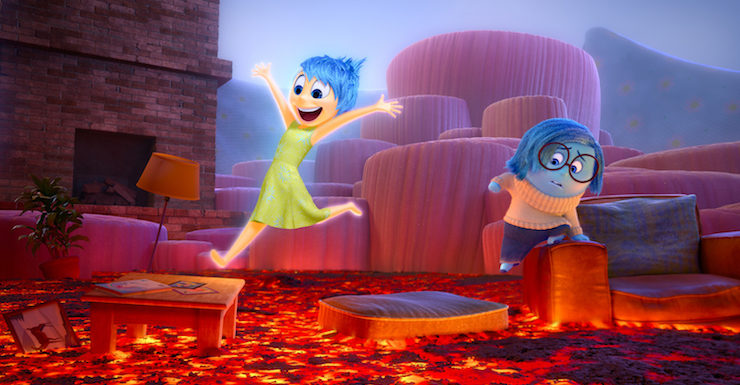Something seemed to be, well, off with the Pixar brand after the brilliant Toy Story 3 (2010). Perhaps, critics whispered, that something was parent company Disney, who had insisted that Pixar create a sequel to one of its lesser regarded films, Cars (2006), leading to the beautiful but largely bland Cars 2 (2011), and followed up with a demand for a Disney Princess film, Brave (2012)—not exactly in the wheelhouse of the male-dominated Pixar films. Or perhaps that something was the multiple demands on John Lasseter, still supervising Pixar’s creative team, but also charged with bringing the Disney Animation Studios back from the brink of yet another creative downturn. After all, the Disney Animation Studios were starting to produce films that felt rather like Pixar films—most notably with Wreck-It-Ralph (2012)—making it rather easy to assume that Lasseter’s attention was focused more on Disney than Pixar. Perhaps it was the absence of Steve Jobs, who had died in 2011.
Or perhaps, others argued, the Pixar brand had never been all that amazing to begin with—sure, the studio had given us the Toy Story films and Finding Nemo (2003), but their films had also included the relatively weak A Bug’s Life (1998) and the aforementioned Cars. Maybe the astonishing streak of films between 2007 and 2010—Ratatouille (2007), WALL-E (2008), Up (2009), and Toy Story 3 (2010)—was just, well, a lucky, astonishing streak of films, a creative burst that would not be repeated. The Disney Animation Studios, after all, had enjoyed—or suffered—similar trends: a few years of great films all in a row, marked by decidedly weaker films in the middle.
Whatever the reason, the Pixar films after Toy Story 3 (2010) were, well, missing something.
Luckily, Pixar had something of their own: writer/director Pete Docter, who thought that animating human emotions might be fun.
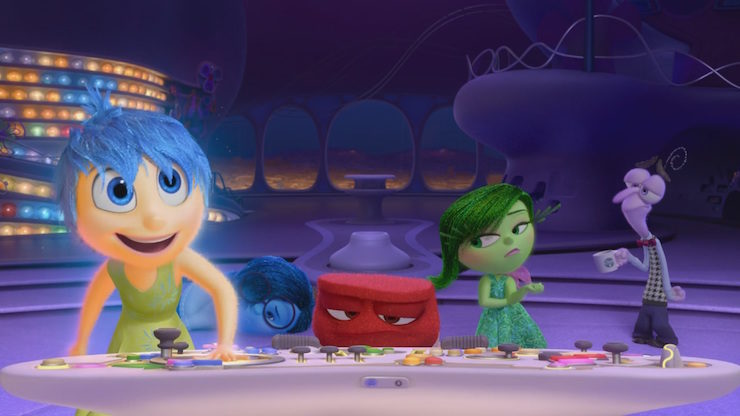
Pete Docter had joined Pixar in the very early days, helping storyboard Toy Story. He later went on to write and direct the very successful Monsters, Inc. (2001) and Up (2009), and direct the English dub of Howl’s Moving Castle (2004). Disney’s purchase of Pixar in 2006 also pulled Docter into other Disney projects; for instance, after finishing Up, he joined other top Pixar creatives to help shape and polish the script for The Muppets (2011), while continuing to work as an executive producer for Monsters University (2013) and various Pixar shorts.
Most of his time post Up, however, was spent trying to work out the script for his new idea: a film that would animate not just characters, but emotions. Docter had been watching the emotional changes in his young daughter, which sparked some thoughts and memories of his own—and an interest in just how much emotions control our behaviors. He consulted various psychology tomes and experts, including Paul Ekman and Dacher Keltner and also assembled a writing team. The concept, he knew, would need work to be at all credible on screen. A lot of work.
This turned out to be a bit of an underestimation. Even in the context of a studio notorious for going through multiple script rewrites for each and every film, the scriptwriting process for Inside Out stands out, going through three years of storyboarding alone before anyone at Pixar was even remotely satisfied with the film’s plot. Film editor Kevin Notling later told The Hollywood Reporter that about seven different versions of Inside Out were made before the film even went into production—something that Notling claimed wasn’t unusual for Pixar, but something not exactly said of other Pixar films, either. Notling may have meant that this wasn’t unusual for Pete Docter films.
The script continued to be tinkered with until the very end, with Notling doing additional story edits during the layout/planning process. Production designer Ralph Eggleston later claimed that the five and a half years he spent on Inside Out were the longest he spent on any Pixar film—reflecting the many changes to concepts and the plot. Several elements were considered and then dropped, most notably the original plan: to tell a story of a journey by Joy and Fear. Great for comedy: less great, Docter realized, for plot and emotion. Instead, Docter decided—in a change made after the film had moved into production—that Joy would travel with Sadness, a journey that would pack more of an emotional punch—and allow Pixar to explore, once again, the importance of accepting grief and change.
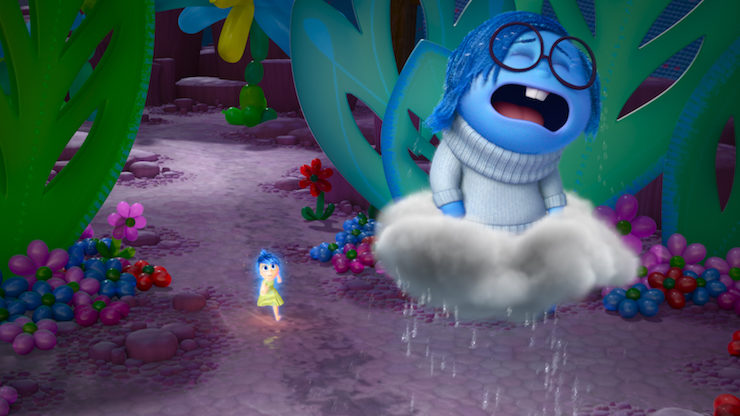
Pixar also considered adding other emotions, but eventually decided to stick with six core emotions: Joy, Fear, Sadness, Anger, Disgust and Surprise—partly because these were the core emotions named by Paul Ekman, and mostly for the sake of keeping the story/plot relatively simple. (And since this was still a kids film—if the most adult of the Pixar films other than arguably Up—Lust/Desire was left out completely.) After more tinkering, animators realized that from a plot point of view, Surprise tended to mirror Fear, Anger and Disgust—so Surprise, too, was dropped.
E….veennntually, Docter and other writers and storyboarders nailed down a script focusing on the inner life of eleven-year-old Riley—and the depression, anger and fear that almost destroys the pillars that form her personality—and almost destroys her inner joy. The final plot was inspired partly by Docter’s own early life, when he moved with his family to Denmark and found socializing difficult, and partly by the need to find an outside impetus to spark a plot for the Emotion characters. Moving tends to be stressful and emotional for anyone of any age, and Docter and the story artists found a lot to mine from the concept of moving from Minnesota, which has ice hockey, to San Francisco, which has weird pizza.
(Sidenote: look, San Francisco, I’m honestly trying not to judge, but pizza, by definition, is supposed to be bad for you. Don’t ruin the entire point by putting broccoli on it. Honestly. Do we need to send armies of Disgusts over to you to make our point?)
If the script process was a near nightmare, the animation process, for once, went relatively smoothly. It helped that for once Pixar was not upgrading hardware or rendering software, eliminating quite a bit of the frantic last minute compiling and rendering work. The production staff only had one major hiccup: right after animators had decided to ditch the bubbly texture of Joy’s skin (meant to suggest that she was formed of several tiny bubbles), giving her a sparkly appearance, thanks to the expense and difficulty of animating it, John Lasseter looked at the texture and told animators to use it for every emotion. That hiccup forced Pixar animators to, as headlines of the time put it, blow right through the initial budget for the film—without even considering the added costs of the multiple rewrites.
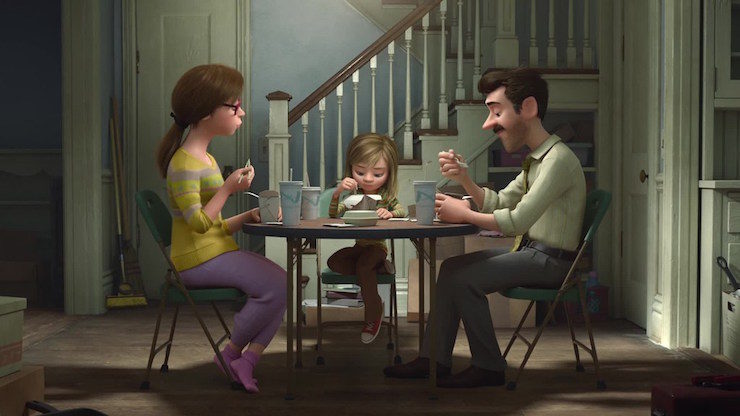
On the other hand, since the budget was already blown anyway, this also allowed Pixar to create one of its most imaginative worlds yet—all the brighter and more bubbly for appearing in constant contrast to the considerably duller “real world” images. Duller—but no less impressive, with several shots achieving photo or near photo realism. If you have the DVD/Blu-Ray, take a moment to pause when Riley and her family are on screen and look at their skin. Thanks to continuous improvements in rendering software—now shared between Disney and Pixar—it almost looks, well, real.
The comparatively smooth animation process also allowed animators to take the time to do more than the usual amount of tailoring the film for individual countries—something nearly commonplace by this time in Disney films. Japanese viewers, for instance, saw green peppers instead of broccoli (even though green peppers, unlike broccoli, can be delicious on pizza, take note, San Francisco). Some countries watched Riley’s father daydream about hockey; other countries, soccer.
Contributing to the animation and development process: various suggestions from the vocal talents, many of whom were hired before the script was even finalized, starting with Richard Kind, stalwart of several previous Pixar films, to voice Riley’s imaginary friend Bing Bong. With Kind firmly signed on, they asked him to approach Amy Poehler of Parks and Recreation, the natural choice for optimistic yet bossy Joy. (Kind and Poehler had worked together on Saturday Night Live.) For Sadness, Pixar tapped Phyllis Smith, then and now probably best known for her work on The Office. For Anger, Pixar had, right from the beginning, only one choice: comedian Lewis Black—going to the extent of giving Anger a red tie and dress shirt and a tendency to read newspapers, all nods to Black’s standup routines.
The only slight failure here: Mindy Kaling as Disgust, and that not because of anything with Kaling’s performance, but rather because Disgust really isn’t given all that much to do in the film—though she does get one nice heroic moment where she saves Joy and Sadness from plunging to their doom. Partly this was thanks to the decision to have only two emotions, Joy and Sadness, explore the world of the inner mind, leaving the other three Emotions with much less to do to start with, partly thanks to the understandable plot decision to have Anger drive several remaining plot points, and let Fear watch over the mind during the dream sequences, and mostly thanks to the decision to let Joy experience every one of the other emotions—Fear, Sadness, Anger and Disgust—as she travelled, limiting Disgust’s role still further. Still, Kaling seems like such ideal casting for Disgust that I found myself sorry that she didn’t do more.
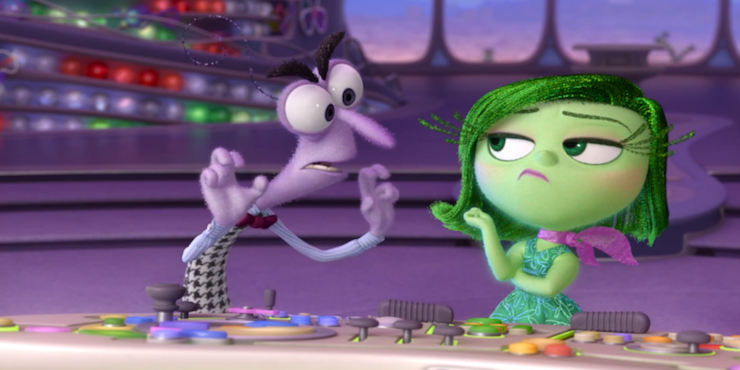
But that’s a slight quibble in what is otherwise one of Pixar’s best films. Oh, sure, it’s yet another tearjerker (though I cannot confirm that I was forced to consume medicinal chocolate while watching this film) and yes, because it’s a kiddie film, it has all kinds of Big Moral Messages. Then again, because it’s a Pixar film, these tend to be Big Moral Messages that I can embrace: like, kids, if you let Anger take over, you might find yourself making some very bad decisions, and that yes, sometimes it is okay—and even important, to let Sadness take over for a bit, and let yourself cry.
Inside Out is also stuffed full of visual delights—not just the astonishing inner worlds and islands that make up Riley’s personality, or the rolling balls of memory carefully processed by the emotions and other denizens of Riley’s inner world, but tiny visual jokes—everything from, okay, slightly self-promoting moments like a clownfish game called Find Me (this is my head smacking my desk) to a movie poster based on the original movie poster created for Vertigo. It’s also funny—with everything from an ongoing joke about Triple Dent gum (I laughed nearly every time), to the image of little creatures dragging “useless” memories of things like the names of Vice Presidents away and dumping them into a void never to be found again (if only because this is a wonderful excuse for pretty much everything in my life so I’m stealing it), to the sendup of a television studio (filming Riley’s dreams), to the glimpses of the inner life or others, to Muppeteers Frank Oz and Dave Goelz suddenly appearing as two guards who should be watching over the gates to Riley’s subconscious and instead are talking about hats.
But I think what makes Inside Out work so well is that even with the silliness of the thought of a television studio setting up work inside the mind of an 11 year old, and the idea of a needing to take a train to get to various places within your mind, and the wildly inventive architecture of the various mental places, all of the Bad Things that happen to Riley in San Francisco are at a realistic 11 year old level: that broccoli pizza; a teacher calling on her on the first day of class; a mistake in hockey tryouts; and—the worst—learning that her best friend back in Minnesota has already met someone really cool, like, sometimes, Skype creates more problems than it solves. All things that adults know are devastating but survivable—but unbearable when you’re eleven, and all realistic choices that ground an otherwise almost over the top creatively film, giving it emotional weight.
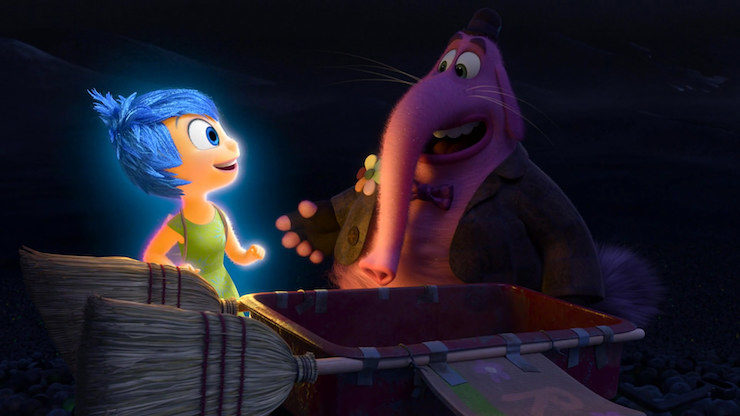
I am not alone in this opinion. Inside Out was a decided success, earning $857.6 million at the box office, somewhat making up for the decision to spend all that money to give every emotion character that bubbly look. The film received almost universal critical praise, along with an Academy Award nomination for Best Original Screenplay and an Oscar for Best Animated Film and a Golden Globe Award for Best Animated Feature Film, and multiple other accolades from different groups. Sadness gifs and images were wildly popular, in particular her “Crying helps me to slow down and obsess over the weight of life’s problems,” which I may have used a couple of times myself. (I’m not saying that Sadness is actually me, but she could be.) Disney released the usual merchandise, some of which remains available today, attesting to its popularity.
Not everyone was delighted: Denise Daniels, a child development expert, alleged that Disney and Pixar had stolen her idea in order to make the film, launching a federal lawsuit against Disney in June 2017. Daniels had created her own show depicting emotions as color coded anthropomorphic characters back in 2005, aiming it at preschoolers dealing with various childhood traumas, even uploading an episode up on YouTube in 2007. The case was dismissed in February 2018 by the United States District Court based in Los Angeles.
I feel impelled to note that an argument could be made that both Daniels and Pixar had ripped off an idea originated by Herman’s Head, a sitcom that aired on Fox back in the 1990s, and that Herman’s Head in turn was working with the idea that we all hear little voices yelling at us, not exactly original to the writers of that sitcom either.
But Daniels was largely alone in her criticism (and lawsuits). For now, at least, it seemed that Pixar was once again triumphant. And ready to take on dinosaurs.
The Good Dinosaur, coming next month.
Mari Ness lives in central Florida.










